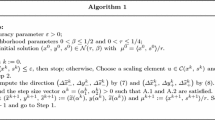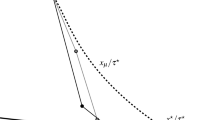Abstract
Interior point methods (IPM) have been developed for all types of constrained optimization problems. In this work the extension of IPM to second order cone programming (SOCP) is studied based on the work of Andersen, Roos, and Terlaky. SOCP minimizes a linear objective function over the direct product of quadratic cones, rotated quadratic cones, and an affine set. It is described in detail how to convert several application problems to SOCP. Moreover, a proof is given of the existence of the step for the infeasible long-step path-following method. Furthermore, variants are developed of both long-step path-following and of predictor-corrector algorithms. Numerical results are presented and analyzed for those variants using test cases obtained from a number of application problems.
Similar content being viewed by others
References
E.D. Andersen, C. Roos, and T. Terlaky, “On implementing a primal-dual interior-point method for conic quadratic optimization,” Mathematical Programming Ser. B, vol. 95, pp. 249-277, 2003.
K.M. Bretthauer and B. Shetty, “The nonlinear resource allocation problem,” Operations Research, vol. 43, pp. 670-683, 1995.
R.W. Freund, F. Jarre, and S. Mizuno, “Convergence of a class of inexact-interior-point algorithm for linear programs,” Mathematics of Operation Research, vol. 24, pp. 50-71, 1999.
Y.J. Kuo, “Interior point algorithm for second-order cone problems with applications,” PhD dissertation, Department of Mathematics and Statistic, Arizona State University, 2002.
M.S. Lobo, L. Vandenberghe, and S. Boyd, “Application of second-order cone programming,” Linear Algebra Application, vol. 284, pp. 193-228, 1998.
S. Mehrotra, “On the implementation of a primal-dual interior point method,” SIAM Journal on Optimization, vol. 2, pp. 575-601, 1992.
H.D. Mittelmann, “An independent benchmarking of SDP and SOCP solvers,” Mathematical Programming Ser. B, vol. 95, pp. 407-430, 2003.
S. Mizuno and F. Jarre, “Global and polynomial-time convergence of an infeasible-interior-point algorithm using inexact computation,” Mathematical Programming, vol. 84, pp. 357-373, 1999.
R.D.C. Monteiro and T. Tsuchiya, “Polynomial convergence of primal-dual algorithms for the second-order cone program based on the MZ-family of directions,” Mathematical Programming, vol. 72, pp. 61-83, 2000.
Y. Nesterov and M. Todd, “Self-scaled barries and interior point mehtods for convex programming,” Mathematics of Operation Research, vol. 22, pp. 1-42, 1997.
F. Potra and R.Q. Sheng, “Homogeneous interior-point algorithms for semidefinite orogramming,” Optimization Methods and Software, vol. 9, pp. 161-184, 1998.
J.F. Sturm, “Using SeDuMi 1.02, a MATLAB toolbox for optimization over symmetric cones,” Optimization Methods and Software, vols. 11/12, pp. 625-653, 1999.
T. Tsuchiya, “A convergence analysis of the scaling-invariant primal-dual path-following algorithms for second-order cone programming,” Optimization Methods and Software, vols. 11/12, pp. 141-182, 1999.
R.H. Tütüncü, K.C. Toh, and M.J. Todd, “Solving semidefinite-quadratic-linear programs using SDPT3,” Mathematical Programming Ser. B, vol. 95, pp. 189-217, 2003.
R.J. Vanderbei and H. Yurttan, “Using LOQO to solve second-order cone programming problems,” Report SOR 98-09, Princeton University, 1998.
R.J. Vanderbei and H. Yurttan, http://www.princeton.edu/~rvdb/ampl/nlmodels/index.html.
J.A. Ventura and C.M. Klein, “A note on multi-item inventory systems with limited capacity,” Operation Research Letters, vol. 7, pp. 71-75, 1988.
S.J. Wright, Primal-Dual Interior-Point Methods. Society for Industrial and Applied Mathematics (SIAM), Philadelphia, PA, 1997.
S.-P. Wu, S. Boyd, and L. Vandenberghe, “FIR filter design via spectral factorization and convex optimization.” Applied and Computational Control, Signals, and Circuits, Biswa Datta editor, Birkhauser, Chap. 5, vol. 1, pp. 215-245, 1998.
H. Ziegler, “Solving certain singly constrained convex optimization problems in production planning,” Operation Research Letters, vol. 1, pp. 246-252, 1982.
Author information
Authors and Affiliations
Rights and permissions
About this article
Cite this article
Kuo, YJ., Mittelmann, H.D. Interior Point Methods for Second-Order Cone Programming and OR Applications. Computational Optimization and Applications 28, 255–285 (2004). https://doi.org/10.1023/B:COAP.0000033964.95511.23
Issue Date:
DOI: https://doi.org/10.1023/B:COAP.0000033964.95511.23




